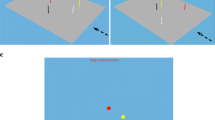Abstract
Reference frames are representations that parse space. In the case of spatial terms, reference frames mediate the mapping of linguistic expressions onto spatial configurations of objects. In the sentence ``The fly is above the cat,'' ``above'' is defined with respect to a reference frame that is imposed on the cat. Different types of reference frames can be used to define spatial terms, each based on a different source of information. For example, gravity, the orientation of objects in the scene or the orientation of the viewer can all be used to set the orientation of a reference frame. When these reference frames disagree (because the viewer is reclining or because the objects in the scene are overturned), there are competing definitions for the spatial term, resulting in the need for reference frame selection. The purpose of this paper is to review a line of research that examines reference frame selection in the context of spatial language. This work shows that all reference frames are initially active and assign a direction to a spatial term. Moreover, this activation is automatic, and is followed by the selection of a single reference frame, with selection accompanied by inhibition of the non-selected frames. Parallels between reference frame selection in language and in perception and attention are discussed.
Similar content being viewed by others
References
Behrmann, M. and Tipper, S.P. (1999). Attention Accesses Multiple Reference Frames: Evidence from Visual Neglect, Journal of Experimental Psychology: Human Perception and Performance 25: 83–101.
Brennan, S.E. and Clark, H.H. (1996). Conceptual Pacts and Lexical Choice in Conversation, Journal of Experimental Psychology: Learning, Memory and Cognition 22: 1482–1493.
Carlson-Radvansky, L.A. and Irwin, D.E. (1993). Frames of Reference in Vision and Language: Where is Above? Cognition 46: 223–244.
Carlson-Radvansky, L.A. and Irwin, D.E. (1994). Reference Frame Activation During Spatial Term Assignment, Journal of Memory and Language 33: 646–671.
Carlson-Radvansky, L.A. and Jiang, Y. (1998). Inhibition Accompanies Reference Frame Selection, Psychological Science 9: 386–391.
Carlson-Radvansky, L.A. and Logan, G.D. (1997). The Influence of Reference Frame Selec-tion on Spatial Template Construction, Journal of Memory and Language 37: 411–437.
Clark, H.H. (1973). Space, Time, Semantics, and the Child. In T. Moore (ed.), Cognitive Development and the Acquisition of Language. San Diego: Academic Press.
Clark, H.H. and Wilkes-Gibbs, D.L. (1986). Referring as a Collaborative Process, Cognition 22: 1–39.
Corballis, M.C., Nagourney, B.A., Shetzer, L.I. and Stefanatos, G. (1978). Mental Rotation Under Head Tilt: Factors Influencing the Location of the Subject Reference Frame, Perception & Psychophysics 24: 263–273.
Crawford, E., Regier, T. and Huttenlocher, J. (in press). Linguistic and Non-linguistic Categorization, Cognition.
Fillmore, C.J. (1975). Santa Cruz Lectures on Deixis. Bloomington, IN: Indiana University Linguistics Club.
Fox, E. (1995). Negative Priming from Ignored Distractors in Visual Selection: A Review, Psychonomic Bulletin & Review 2: 145–173.
Franklin, N., Henkel, L.A. and Zengas, T. (1995). Parsing Surrounding Space Into Regions, Memory & Cognition 23: 397–407.
Franklin, N. and Tversky, B. (1990). Searching Imagined Environments, Journal of Experimental Psychology 119: 63–76.
Friederici, A.D. and Levelt, W.J.M. (1990). Spatial Reference in Weightlessness: Perceptual Factors and Mental Representations, Perception & Psychophysics 47: 253–266.
Garnham, A. (1989). A Unified Theory of Meaning of Some Spatial Relational Terms, Cognition 31: 45–60.
Garrod, S. and Anderson, A. (1987). Saying What you Mean in Dialogue: A Study in Conceptual and Semantic Co-ordination, Cognition 27: 181–218.
Gibson, B.S. and Egeth, H. (1994). Inhibition of Return to Object-based and Environment-based Locations, Perception & Psychophysics 5: 323–339.
Hayward, W.G. and Tarr, M.J. (1995). Spatial Language and Spatial Representation, Cognition 55: 39–84.
Herskovits, A. (1986). Language and Spatial Cognition: An Interdisciplinary Study of the Prepositions of English. Cambridge: Cambridge University Press.
Hinton, G.E. and Parsons, L.M. (1988). Scene-based and Viewer-centered Representations for Comparing Shapes, Cognition 30: 1–35.
Levelt, W.J.M. (1984). Some Perceptual Limitations on Talking About Space. In A.J. van Doorn, W.A. van der Grind and J.J. Koenderink (eds.), Limits in Perception. Utrecht: VNU Science Press, pp. 323–358.
Levinson, S. (1996). Frames of Reference and Molyneux's Questions: Cross-linguistic Evidence. In P. Bloom, M.A. Peterson, L. Nadel and M. Garrett (eds.), Language and space. Cambridge, MA: MIT Press, pp. 109–169.
Logan, G.D. and Sadler, D.D. (1996). A Computational Analysis of the Apprehension of Spatial Relations. In P. Bloom, M.A. Peterson, L. Nadel and M. Garretts (eds.), Language and Space. Cambridge, MA: MIT Press, pp. 493–529.
McMullen, P. and Jolicoeur, P. (1990). The Spatial Frame of Reference in Object Naming and Discrimination of Left-right Reflections, Memory & Cognition 18: 99–115.
Miller, G.A. and Johnson-Laird, P.N. (1976). Language and Perception.Cambridge,MA: Harvard University Press, pp. 374–410.
Morrow, D.G. and Clark, H.H. (1988). Interpreting Words in Spatial Descriptions, Language and Cognitive Processes 3: 275–291.
May, C.P., Kane, M.J. and Hasher, L. (1995). Determinants of Negative Priming, Psycholo-gical Bulletin 118: 35–54.
Neill, W.T. (1977). Inhibitory and Facilitatory Processes in Selective attention, Journal of Experimental Psychology: Human Perception and Performance 3: 444–450.
Schober, M. (1993). Spatial Perspective-taking in Conversation, Cognition 47: 1–24.
Shepard, R.N. and Metzler, J. (1971). Mental Rotation of Three-dimensional Objects, Science 171: 701–703.
Talmy, L. (1983). How Language Structures Spaces. In H.L. Pick and L.P. Acredolo (eds.), Spatial Orientation: Theory, research and application. New York: Plenum Press, pp. 225–282.
Tipper, S.P. (1985). The Negative Priming Effect: Inhibitory Priming by Ignored Objects, Quarterly Journal of Experimental Psychology 37A: 571–590.
Tipper, S.P., Weaver, B., Jerreat, L.M. and Burak, A.L. (1994). Object-and Environment-based Inhibition of Return of Visual Attention, Journal of Experimental Psychology: Human Perception and Performance 20: 478–499.
Author information
Authors and Affiliations
Rights and permissions
About this article
Cite this article
Carlson, L.A. Selecting a reference frame. Spatial Cognition and Computation 1, 365–379 (1999). https://doi.org/10.1023/A:1010071109785
Issue Date:
DOI: https://doi.org/10.1023/A:1010071109785




